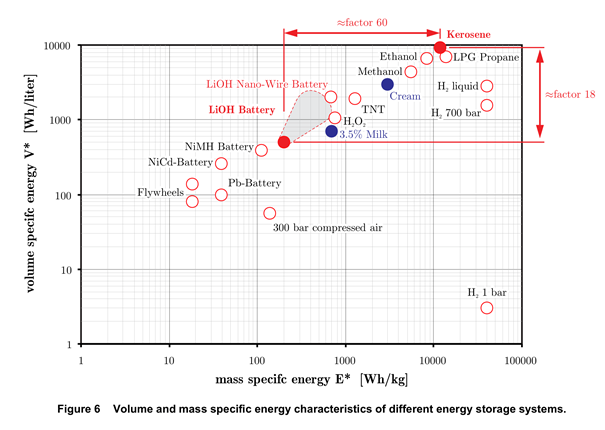[Decarbonizing Aviation] Episode 4: The challenge of alternative sources of energy
If you want to learn more about the opportunities and challenges of aviation decarbonization, you've come to the right place!
|
This mini-series of small articles will present you successively:
In this fourth article, we look at how much energy an aircraft requires, why kerosene has all the right properties, except it's fossil, and the challenge of alternative sources of energy. |
How much power does an aircraft require?
A commercial aircraft is a big machine. It weighs a lot, carries a heavy payload (hundreds of passengers with bags and freight), must fight gravity, and moves very fast — all good reasons for requiring a substantial amount of energy.
The following table is from a presentation by Jean Hermetz, in charge of research on new aircraft configuration at ONERA, the French aerospace lab. The numbers are just astonishing.
|
|
Max Installed Power (MW) |
On-board overall energy (MWh) |
|
Leisure aircraft (e.g. DR400) |
0.11 |
1.2 |
|
Regional aircraft (e.g. ATR 42) |
2.7 |
55 |
|
Single aisle aircraft (e.g. A320) |
40 |
250 |
|
Widebody aircraft (e.g. B777) |
164 |
1110 |
It gives the maximum installed power and the on-board energy when the aircraft is loaded at full capacity of its tanks for various types of aircraft.
To make these numbers less abstract, we'll make two comparisons:
- A sub-compact 4-seat conventional car such as a Renault Zoe has a maximum installed power of ~80 kW and will carry an onboard overall energy of ~0.6 MWh.
This is the same order of magnitude as the leisure aircraft. - A typical civil nuclear reactor produces around 1 GW.
This means that when it flies, a widebody aircraft uses as much power as ~1/10th of a civil nuclear power plant!
In terms of power, large commercial aircraft face a double challenge: they require a high level of power, and they need a lot of available energy with a mastered weight. When you need to fight gravity and move fast, weight is clearly the enemy.
Kerosene has all the right properties, except it's fossil
Kerosene has all the right properties to be aviation fuel.
First of all, it remains liquid and safe at a vast range of temperatures.
Jet fuel freezes only at -47°C (-53°F), which is compatible with the very low-temperature aircraft meet when they fly high in the atmosphere. And jet fuel's autoignition temperature is 220°C (428°F), making it is safe at very high temperatures.
Secondly, it is highly energetic: its combustion produces 43.15 Mj/kg. It means 100 tons of kerosene (the tank capacity of a large aircraft) contain more than 1 GWh of energy. It has a high density of energy per mass and per volume (jet fuel's density is ~0.8 kg/liter).
Since weight is the enemy, energy per mass is very important. If the energy per mass is below a certain threshold, it cannot even fight its own gravity.
But, energy per volume is almost equally important. When you look at pictures from commercial jet aircraft since the 1950's, you might have noticed that their shape has very little changed: they are made of a cylinder-shaped fuselage where the passengers sit and of wings that provide the lift.
This is nothing but a coincidence: this shape and the proportion between the fuselage and the wings has reached an aerodynamic optimum for sub-sonic flights. And it so happens that with this optimal aerodynamic configuration, the volume available in the wings is just what it takes to carry the right amount of kerosene for the aircraft's payload and range.

Read this article to know why fuel is stored in the wings.
This means that kerosene is an excellent energy storage system. Should you substitute kerosene for something else that requires more room because its energy per volume is lower, and you need to reconsider the aircraft's whole shape and aerodynamics, probably for the worse.
And finally, kerosene is cheap. Nature has produced crude oil, and you just need to pay for its extraction, transformation, and handling.
So, kerosene has all the right properties to be aviation's fuel? Yes, except for one big problem: it produces CO2. Each kg of burnt fuel produces 3.15 kg of CO2.
As we saw in Episode 1: How much CO2 does aviation emit?, CO2 is a powerful greenhouse gas and the main reason why our planet Earth is warming up at unprecedented speed. And unfortunately, when CO2 is released in the atmosphere, it is there to stay for 300 to 1,000 years.
Because they release quickly large amounts of CO2 that mother nature took millions of years to capture and transform in its soils, fossil sources of energy are the enemy of our planet and should be phased out as soon as possible.
The challenge of mass density and volume density
Why can't we use other decarbonized energy sources, such as green electricity or green hydrogen (produced from renewable sources of energy or nuclear plants)?
We probably will, but we face multiple technical challenges that we'll detail in the next episodes.
One graph from a research paper by Martin Hepperle at the German Aerospace Center shows the core of the problem: density of energy per mass and volume.

This graph positions various energy storage systems on two axes: the x-axis is the energy density per mass: the more right, the more energy per kg; the y-axis is the energy density per volume: the higher, the more energy per liter.
One important thing to notice on this graph is that it uses a logarithmic scale: each graduation to the right or the top means an x10 increase.
Kerosene is in the top right corner: it excels in energy per mass and energy per volume.
Lithium-ion batteries, which are the most modern batteries used for electronic devices or electric cars, contain 60 times less energy per kg and 18 times less energy per liter!
If we were to replace jet fuel with batteries on an A320, then the batteries' weight would exceed ten times the maximum take-off weight of the aircraft.
Nevertheless, an electrical aircraft can have interesting properties that we'll detail in our next episode: Episode 5: The electrical aircraft.
Hydrogen, if it's liquid or under high pressure, stores a lot of energy per kg, making it a good candidate for aviation where weight is the enemy. But it falls short in terms of energy per volume, which will inevitably lead to different aerodynamic designs. It also poses other challenges that we'll detail in Episode 6: The hydrogen aircraft.
What's up in the next episode?
The next episode of this series is entitled "The electrical aircraft."
It will address the following topics:
- Perspectives in battery improvements
- From the more electrical aircraft to the all electrical aircraft
- Interesting designs made possible with electrical engines
WANT TO LEARN MORE?
Understanding the ReFuel EU Aviation policy >> Read the article



